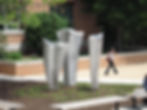

Wind Kinetic Sculpture
Wind-kinetic sculpture continues to advance as artists like Rubenstein integrate engineering, environmental design, and sustainable technologies into their work. This evolving field highlights the boundless potential of motion and viewer interaction, demonstrating how sculpture can become a living, responsive experience within public space.
Rubenstein pioneered a cable-and-bearing mechanism to expand the possibilities of wind-kinetic sculpture, allowing sculptures to be activated by natural forces such as wind and water. This innovation transforms static forms into fluid, ever-changing compositions, redefining traditional sculpture through movement and environmental engagement—a core principle of wind-powered kinetic art.
Drawing from his scientific and engineering background, Rubenstein creates dynamic site-specific public installations that respond to atmosphere, gravity, and natural flow.
His work emphasizes the ephemeral beauty of motion, illustrating how kinetic art can reshape civic environments, celebrate nature's rhythms, and deepen public connection to the environment. Through ongoing experimentation, Rubenstein continues to expand the language of kinetic sculpture and its role in contemporary environmental public art.





















